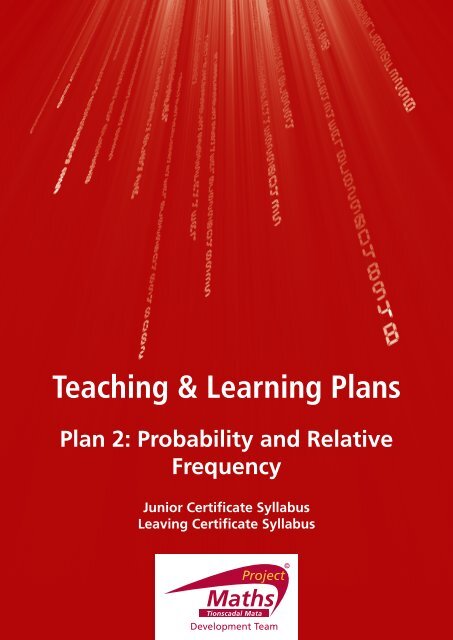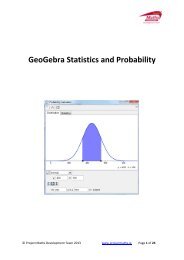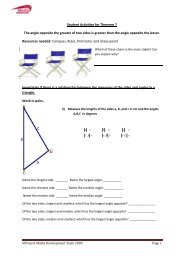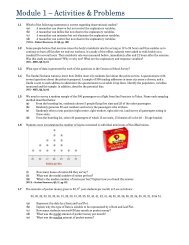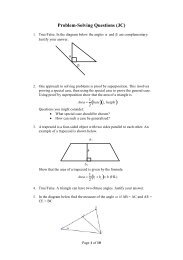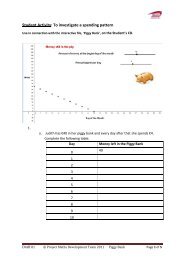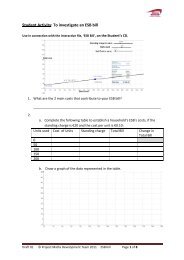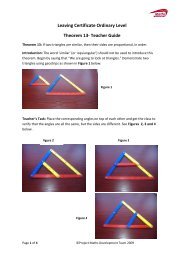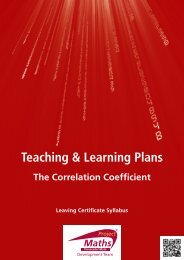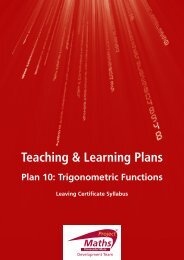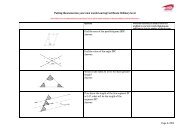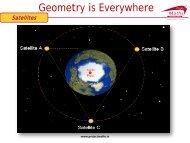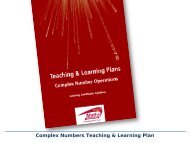Teaching & Learning Plans - Project Maths
Teaching & Learning Plans - Project Maths
Teaching & Learning Plans - Project Maths
Create successful ePaper yourself
Turn your PDF publications into a flip-book with our unique Google optimized e-Paper software.
<strong>Teaching</strong> & <strong>Learning</strong> <strong>Plans</strong><br />
Plan 2: Probability and Relative<br />
Frequency<br />
Junior Certificate Syllabus<br />
Leaving Certificate Syllabus
The <strong>Teaching</strong> & <strong>Learning</strong> <strong>Plans</strong><br />
are structured as follows:<br />
Aims outline what the lesson, or series of lessons, hopes to achieve.<br />
Prior Knowledge points to relevant knowledge students may already have and also<br />
to knowledge which may be necessary in order to support them in accessing this new<br />
topic.<br />
<strong>Learning</strong> Outcomes outline what a student will be able to do, know and understand<br />
having completed the topic.<br />
Relationship to Syllabus refers to the relevant section of either the Junior and/or<br />
Leaving Certificate Syllabus.<br />
Resources Required lists the resources which will be needed in the teaching and<br />
learning of a particular topic.<br />
Introducing the topic (in some plans only) outlines an approach to introducing the<br />
topic.<br />
Lesson Interaction is set out under four sub-headings:<br />
i. Student <strong>Learning</strong> Tasks – Teacher Input: This section focuses on teacher input<br />
and gives details of the key student tasks and teacher questions which move the<br />
lesson forward.<br />
ii.<br />
Student Activities – Possible and Expected Responses: Gives details of<br />
possible student reactions and responses and possible misconceptions students<br />
may have.<br />
iii. Teacher’s Support and Actions: Gives details of teacher actions designed to<br />
support and scaffold student learning.<br />
iv.<br />
Checking Understanding: Suggests questions a teacher might ask to evaluate<br />
whether the goals/learning outcomes are being/have been achieved. This<br />
evaluation will inform and direct the teaching and learning activities of the next<br />
class(es).<br />
Student Activities linked to the lesson(s) are provided at the end of each plan.
<strong>Teaching</strong> & <strong>Learning</strong> Plan 2:<br />
Probability and Relative<br />
Frequency<br />
Aims<br />
• To introduce the concept of ‘outcomes’ of an ‘event’<br />
• To estimate likelihood of occurrence of events<br />
• To establish the ‘Sample Space’ as the set of all possible outcomes<br />
Prior Knowledge<br />
Students should have prior knowledge (from T and L Plan 1 and/or from primary school)<br />
of some terms associated with chance and uncertainty. They should be familiar with<br />
probability expressed as a fraction or decimal in the range 0 to 1, or as a percentage in<br />
the range 0% to 100%.<br />
<strong>Learning</strong> Outcomes<br />
As a result of studying this topic, students will be able to<br />
• understand and use the following terminology: trial, outcome, set of<br />
all possible outcomes, relative frequency, event, theoretical probability,<br />
equally likely outcomes<br />
• list all the possible outcomes when rolling a fair die<br />
• recognise that the outcomes on successive throws of a die are independent<br />
of each other<br />
• calculate, from experimental results, the relative frequency for each<br />
outcome and note how it approaches the theoretical probability as the<br />
number of trials increases<br />
• understand the concept of a fair die<br />
• distinguish equally likely outcomes from those which are not<br />
• associate probability with long-run relative frequency<br />
© <strong>Project</strong> <strong>Maths</strong> Development Team 2009 www.projectmaths.ie 1
<strong>Teaching</strong> & <strong>Learning</strong> Plan 2: Probability and Relative Frequency<br />
Relationship to Junior Certificate Syllabus<br />
Sub-topics Ordinary Level Higher Level (Inc.OL)<br />
1.5 Counting Listing outcomes of<br />
experiments in a systematic<br />
way<br />
1.6 Concepts of<br />
probability<br />
Recognise that probability is<br />
a measure on a scale of 0-1<br />
(and 0-100%) of how likely an<br />
event is to occur.<br />
Estimate probabilities from<br />
experimental data.<br />
1.7 Outcomes<br />
of simple<br />
random<br />
processes<br />
Associate the probability of<br />
an event with its long-run,<br />
relative frequency.<br />
Apply the principle that, in<br />
the case of equally likely<br />
outcomes, the probability<br />
is given by the number of<br />
outcomes of interest divided<br />
by the total number of<br />
outcomes.<br />
Relationship to Leaving Certificate Syllabus<br />
Sub-topics Foundation Level Ordinary Level<br />
1.1 Counting List outcomes of an<br />
experiment.<br />
1.2 Concepts of<br />
probability<br />
1.3 Outcomes<br />
of random<br />
processes<br />
Apply the fundamental<br />
principle of counting.<br />
Recognise that probability is a<br />
measure on a scale of 0-1 of<br />
how likely an event is to occur.<br />
Apply the principle that, in<br />
the case of equally likely<br />
outcomes, the probability<br />
is given by the number of<br />
outcomes of interest divided<br />
by the total number of<br />
outcomes.<br />
Estimate probabilities from<br />
experimental data.<br />
Associate the probability of<br />
an event with its long-run,<br />
relative frequency.<br />
Resources Required<br />
A die for each pair of students<br />
© <strong>Project</strong> <strong>Maths</strong> Development Team 2009 www.projectmaths.ie 2
<strong>Teaching</strong> & <strong>Learning</strong> Plan 2: Probability and Relative Frequency<br />
Introducing the Topic<br />
An “Event”<br />
Following from our last lesson we know that, directly or indirectly, probability or chance<br />
plays a role in a wide range of activities. We often make statements which involve terms<br />
such as the likelihood or the chance of occurrence of an event – what do we mean by<br />
an ‘event’?<br />
• ‘It will probably rain today’. The event is ‘It will rain today.’<br />
• ‘Though we are sending the national team to the Olympics, we cannot<br />
confidently predict that we shall win a gold medal’. The event is ‘We shall<br />
win a gold medal’.<br />
• ‘There is a chance that Roy Keane will manage the Irish Football team.’ The<br />
event is ‘Roy Keane will manage the Irish football team.<br />
Each statement above suggests an event whose occurrence or non-occurrence involves<br />
an element of uncertainty.<br />
Estimating the chance of an ‘event’ occurring?<br />
Because of past information or currently available statistics for an event, we can predict,<br />
with some degree of confidence, what the outcome of the event will be.<br />
The past performance of Brazil’s football team in the World Cup can help us to estimate<br />
the probability of the team winning the next World Cup (they have won 5 out of the<br />
last 12 world cups: 1958, 1962, 1970, 1994 and 2002).<br />
Thus, for example, we may make the statement (a) above if most of the days we have<br />
observed recently were rainy days.<br />
Associating numbers with phrases like “very likely” and<br />
“probably”<br />
In conversation we might say that it was ‘very warm’ yesterday. Would this have the<br />
same meaning for a person living in central Australia as for someone living in Birr? How<br />
can we be clearer about what “very warm” means? The expert from the Meteorological<br />
Office would state the maximum temperature in degrees C, thus quantifying the<br />
situation.<br />
Similarly a person might describe himself as ‘having big feet’, but when it comes to<br />
buying shoes, a more exact description, i.e. shoe size, is needed.<br />
Terms like ‘most likely’ and ‘probably’ are too vague for many purposes; so, ways of<br />
measuring probability have been devised.<br />
© <strong>Project</strong> <strong>Maths</strong> Development Team 2009 www.projectmaths.ie 3
<strong>Teaching</strong> & <strong>Learning</strong> Plan 2: Probability and Relative Frequency<br />
Real Life Context<br />
Apart from gambling, (mention Las Vegas) the theory of probability can help us make<br />
relatively reasonable choices in our daily lives.<br />
Students choose college courses which have a high probability of leading to employment<br />
after college.<br />
Many people have left New Orleans for good because there is a high probability of<br />
devastating hurricanes in that region.<br />
People don’t smoke because there is a high probability of their developing cancer as a<br />
result of smoking.<br />
Probability has widespread use in business, science and industry. Its uses range from<br />
the determination of life insurance premiums to the description of the behaviour of<br />
molecules in a gas and also the prediction of the outcomes of an election.<br />
© <strong>Project</strong> <strong>Maths</strong> Development Team 2009 www.projectmaths.ie 4
<strong>Teaching</strong> & <strong>Learning</strong> Plan 2: Probability and Relative Frequency<br />
Student <strong>Learning</strong> Tasks:<br />
Teacher Input<br />
»» When you toss a die what<br />
are the possible outcomes?<br />
»» When you toss a die which<br />
number is most likely to<br />
appear?<br />
»»<br />
Which is least likely?<br />
»» Write down your answer<br />
individually on the top of<br />
Student Activity 1A.<br />
Student Activities: Possible<br />
and Expected Responses<br />
1, 2, 3, 4, 5, 6<br />
Lesson Interaction<br />
Teacher’s Support and<br />
Actions<br />
»»<br />
Tell the class that we call<br />
this set of all possible<br />
outcomes “the sample<br />
space”.<br />
»»<br />
Distribute Student Activity<br />
1.<br />
»» By walking around ensure<br />
that everyone has made a<br />
guess.<br />
• Ask an individual student.<br />
• Most likely__________<br />
• Least likely__________<br />
Checking Understanding<br />
»» Do the students’ answers<br />
show misconceptions?<br />
This may influence your<br />
decision on the next part –<br />
whether to ask students to<br />
do 30 or 50 rolls of the die.<br />
»» Do the students know how<br />
to do tally marks?<br />
»» Working in pairs, roll a die<br />
30 times (i.e. 30 trials) and<br />
fill in columns 2 and 3 on<br />
Student Activity 1B.<br />
»»<br />
Give a die to each pair.<br />
»» Are students using correct<br />
terminology, e.g. what was<br />
the outcome for that trial?<br />
© <strong>Project</strong> <strong>Maths</strong> Development Team 2009 www.projectmaths.ie KEY: » next step and apply to all • student answer/response 5
<strong>Teaching</strong> & <strong>Learning</strong> Plan 2: Probability and Relative Frequency<br />
Student <strong>Learning</strong> Tasks:<br />
Teacher Input<br />
»» Fill your results onto the<br />
Master Table A on the<br />
board when you have<br />
completed columns 2 and<br />
3.<br />
Student Activities: Possible<br />
and Expected Responses<br />
»» As students finish they fill<br />
results into the Master<br />
Table A on the board i.e.<br />
the frequencies of 1’s, 2’s,<br />
etc. for each group.<br />
Teacher’s Support and<br />
Actions<br />
»» Put an A3 size copy of<br />
Master Table A (as in<br />
Student Activity 2A) on the<br />
board.<br />
»» Collect all dice. While<br />
collecting dice note what<br />
the last column adds up to<br />
for each group.<br />
Checking Understanding<br />
»»<br />
Look at the Master Table<br />
A, did every group get the<br />
same number of 1’s or 2’s<br />
etc. for 30 trials?<br />
»»<br />
Is there a trend appearing?<br />
»» Students can see that their<br />
results are not the same<br />
but similar.<br />
»» Students might suggest<br />
calculating the average<br />
number of 1’s etc.<br />
»» Give groups a minute to<br />
look at the results from the<br />
class and compare the class<br />
results to their own.<br />
»»<br />
Do students notice a trend<br />
in the outcomes?<br />
»» Students can calculate the<br />
average numbers of 1’s etc.<br />
and inform the class.<br />
»» Calculate the relative<br />
frequency for each<br />
outcome (column 4)<br />
and the corresponding<br />
percentages in column 5<br />
(Student Activity 1B)<br />
»» Students calculate the<br />
relative frequencies and<br />
should see that they are all<br />
almost equal.<br />
»» Circulate checking students<br />
‘calculations asking<br />
questions where necessary.<br />
»» Are students beginning to<br />
see that all outcomes are<br />
equally likely?<br />
© <strong>Project</strong> <strong>Maths</strong> Development Team 2009 www.projectmaths.ie KEY: » next step and apply to all • student answer/response 6
<strong>Teaching</strong> & <strong>Learning</strong> Plan 2: Probability and Relative Frequency<br />
Student <strong>Learning</strong> Tasks:<br />
Teacher Input<br />
»» If you add up all the values<br />
in the last 2 columns in<br />
your own table (Student<br />
Activity 1B) what do they<br />
add up to?<br />
»» Fill these answers into<br />
Student Activity 1C.<br />
»» There is a connection<br />
between probability and<br />
relative frequency which<br />
we will come back to later<br />
in the lesson.<br />
»» From the last lesson,<br />
what did 1 mean on the<br />
probability scale?<br />
»» What outcomes are you<br />
certain to get with this die?<br />
»» What do you notice<br />
about your results? Do<br />
they confirm /refute your<br />
prediction?<br />
»» Write down a conclusion<br />
(Student Activity 1D)<br />
and refer back to your<br />
prediction and why you<br />
made that prediction.<br />
Student Activities: Possible<br />
and Expected Responses<br />
1 and 100%<br />
Teacher’s Support and<br />
Actions<br />
»»<br />
moments to consider their<br />
answers and then ask<br />
different groups for their<br />
answers, so that the class<br />
realises everyone got 1.<br />
• Give students a few<br />
• “1” meant certainty.<br />
• 1 or 2 or 3 or 4 or 5 or 6.<br />
The probability of getting<br />
one of these numbers is 1.<br />
»» Students write up their<br />
conclusions.<br />
»» Different groups read out<br />
their conclusion and if it<br />
is in agreement with their<br />
prediction, give reasons<br />
why they made that<br />
prediction.<br />
»» Ask those who didn’t get<br />
1 to recheck their answers.<br />
Circulate and help with<br />
queries.<br />
»» While walking around<br />
check that everyone has<br />
added up last 2 columns<br />
and has got 1 and 100%.<br />
»» Circulate giving advice<br />
where necessary, asking<br />
some groups to state<br />
their conclusions to the<br />
class while checking that<br />
each group has a written<br />
conclusion.<br />
Checking Understanding<br />
»» Have all students realised<br />
that the sum of all the<br />
probabilities for a sample<br />
space is 1?<br />
»» Was each group able to<br />
make a written conclusion?<br />
© <strong>Project</strong> <strong>Maths</strong> Development Team 2009 www.projectmaths.ie KEY: » next step and apply to all • student answer/response 7
<strong>Teaching</strong> & <strong>Learning</strong> Plan 2: Probability and Relative Frequency<br />
Student <strong>Learning</strong> Tasks:<br />
Teacher Input<br />
»» How might you modify<br />
this experiment so that<br />
you could have more<br />
confidence in your<br />
conclusion?<br />
Student Activities: Possible<br />
and Expected Responses<br />
»» Students may suggest more<br />
trials.<br />
Teacher’s Support and<br />
Actions<br />
Checking Understanding<br />
»» How might we look at the<br />
results for a larger number<br />
of trials?<br />
»» Students suggest using the<br />
set of class results from:<br />
Master Table A on the<br />
board.<br />
»» Do students expect less<br />
variation and clearer trends<br />
with more trials?<br />
»»<br />
Copy Master Table A from<br />
the board and fill in class<br />
results.<br />
»» Calculate the relative<br />
frequency for each<br />
outcome (column 4)<br />
and the corresponding<br />
percentages (column 5) for<br />
each outcome.<br />
»» Now that you have over<br />
300 trials can you see any<br />
pattern emerging? Write a<br />
conclusion, referring again<br />
to your prediction.<br />
»» Students make out their<br />
own Master Table and do<br />
the calculations (Student<br />
Activity 2B) and write<br />
a conclusion (Student<br />
Activity 2C) comparing it<br />
with their conclusion from<br />
30 trials.<br />
»» This time different students<br />
read out their conclusions<br />
noting any differences with<br />
the last time – trend clearer<br />
with more trials.<br />
»» Students note that the<br />
relative frequency of each<br />
outcome is the same i.e.<br />
1/6. approx.<br />
»» Walk around and check<br />
the prediction against the<br />
experimental results and<br />
ask students why they<br />
made that prediction.<br />
»» Ask those who thought 6<br />
was the hardest to get and<br />
why they thought this.<br />
(Experience from board games,<br />
biggest number?)<br />
»» Did students see a clearer<br />
pattern of almost equally<br />
likely outcomes from the<br />
larger number of trials?<br />
»» Did students who had<br />
thought that 6 was harder<br />
to get acknowledge their<br />
misconception?<br />
© <strong>Project</strong> <strong>Maths</strong> Development Team 2009 www.projectmaths.ie KEY: » next step and apply to all • student answer/response 8
<strong>Teaching</strong> & <strong>Learning</strong> Plan 2: Probability and Relative Frequency<br />
Student <strong>Learning</strong> Tasks:<br />
Teacher Input<br />
»» Individually draw a graph<br />
on graph paper using<br />
the data from the Master<br />
Table.<br />
»»<br />
Write a conclusion.<br />
Student Activities: Possible<br />
and Expected Responses<br />
»» Students choose the type<br />
of graph to draw, for<br />
example a bar chart.<br />
»» Students may draw<br />
different graphs.<br />
Students comment on the<br />
effectiveness of their graph<br />
in illustrating a trend.<br />
Students could also draw a<br />
graph of their own results<br />
comparing it to the class<br />
Master Table results.<br />
Teacher’s Support and<br />
Actions<br />
»» Circulate giving hints /help<br />
where necessary.<br />
»» Circulate reading the<br />
conclusions, asking a few<br />
students to read out theirs<br />
to the class.<br />
Note: Possible use of Autograph<br />
–simulating throwing a die<br />
thousands of times.<br />
Checking Understanding<br />
»» Conclusions from graphs<br />
should be consistent with<br />
those from tables.<br />
»» Because all outcomes are<br />
equally likely can you think<br />
of a word to describe a die<br />
like this if it were used in a<br />
game which gave everyone<br />
the same chance?<br />
• Some students may come<br />
up with the word “fair”.<br />
»» Give the word ‘unbiased’, if<br />
the students don’t suggest<br />
it and reiterate that what is<br />
meant by a fair die is that<br />
all outcomes are equally<br />
likely.<br />
»» The menu choices for<br />
today’s lunch are pizza,<br />
roast beef and salad. Is<br />
the probability that I will<br />
choose pizza = 1/3?<br />
• Yes<br />
• I am allergic to cheese so<br />
the probability that I would<br />
choose pizza is zero.<br />
• I am a vegetarian and<br />
would never choose beef.<br />
© <strong>Project</strong> <strong>Maths</strong> Development Team 2009 www.projectmaths.ie KEY: » next step and apply to all • student answer/response 9
<strong>Teaching</strong> & <strong>Learning</strong> Plan 2: Probability and Relative Frequency<br />
Student <strong>Learning</strong> Tasks: Teacher Input<br />
»» What is different about this and the<br />
outcomes for the fair die?<br />
»» How might we find out the<br />
probability?<br />
Student Activities: Possible<br />
and Expected Responses<br />
• They are not all equally<br />
likely.<br />
• We might do a survey but<br />
could only get estimated<br />
values of the probability<br />
as outcomes are not<br />
equally likely.<br />
Teacher’s Support and<br />
Actions<br />
»» Give students a minute<br />
to discuss this in their<br />
group and then ask<br />
different groups. If<br />
someone answers ‘yes’,<br />
ask if anyone else has a<br />
suggestion.<br />
Checking<br />
Understanding<br />
»» Can students<br />
distinguish between<br />
‘equally likely ‘and<br />
‘not equally likely’?<br />
»» Can you think of other examples of<br />
situations where the outcomes are<br />
not equally likely?<br />
• In horse racing – depends<br />
on form, jockey, etc.<br />
• 5 people going for an<br />
interview do not all<br />
have an equal chance of<br />
getting the job.<br />
»» Pose the question to<br />
the class and take<br />
answers as students put<br />
up their hands.<br />
»» Did students actively<br />
participate in the<br />
discussion, giving lots<br />
of ideas and showing<br />
understanding?<br />
»» The last approach is known as<br />
the ‘experimental ‘or ‘empirical<br />
approach’ to calculating probabilities.<br />
However, we did not calculate<br />
probabilities but instead calculated<br />
the relative frequencies – so what is<br />
the connection with probability? Has<br />
anyone got any ideas on this?<br />
Note: (Students who may see the<br />
connection need to be allowed say so).<br />
»» What do you think would be the<br />
value of the relative frequencies if we<br />
did more and more trials?<br />
• Loaded die , die with, say,<br />
two 1’s and two 2’s, etc.<br />
• Experiments give<br />
estimates of theoretical<br />
probability based on the<br />
relative frequency of<br />
each outcome. Relative<br />
frequency tends towards<br />
the probability as the<br />
number of trials gets very<br />
large.<br />
• They would get closer and<br />
closer to 1/6 and hence<br />
would all be the same.<br />
© <strong>Project</strong> <strong>Maths</strong> Development Team 2009 www.projectmaths.ie KEY: » next step and apply to all • student answer/response 10
<strong>Teaching</strong> & <strong>Learning</strong> Plan 2: Probability and Relative Frequency<br />
Student <strong>Learning</strong> Tasks:<br />
Teacher Input<br />
»» Based on what you now<br />
know about probability<br />
and its relationship to long<br />
term relative frequency,<br />
and also based on the<br />
bar chart representing<br />
the frequency of each<br />
outcome, can you now fill<br />
in the last column 6 in the<br />
Master Table A?<br />
Student Activities: Possible and<br />
Expected Responses<br />
»» Students fill in 1/6 for the<br />
probability of each outcome.<br />
Teacher’s Support and Actions<br />
»» If the number of trials has<br />
not been sufficiently large<br />
students may not see that<br />
the outcomes are equally<br />
likely so either repeat with<br />
a larger number of trials or<br />
use of a computer generated<br />
simulation. This should<br />
convince students that all<br />
outcomes are equally likely.<br />
Checking<br />
Understanding<br />
»» Have all students<br />
been able to<br />
complete the<br />
probability column<br />
correctly?<br />
Reflection<br />
»» Write down 3 items you<br />
learned about probability<br />
today.<br />
1. All outcomes are equally likely<br />
when tossing a fair die.<br />
2. Relative frequency = frequency<br />
of outcome divided by the<br />
number of trials.<br />
• Circulate and take note<br />
particularly of any questions<br />
students have and help them<br />
to answer these.<br />
3. Equally likely outcomes all<br />
have an equal probability of<br />
occurring.<br />
4. Relative frequency =<br />
probability for an infinite<br />
number of trials where<br />
outcomes are equally likely.<br />
»»<br />
»»<br />
Write down anything you<br />
found difficult.<br />
Write down any question<br />
you may have.<br />
© <strong>Project</strong> <strong>Maths</strong> Development Team 2009 www.projectmaths.ie KEY: » next step and apply to all • student answer/response 11
<strong>Teaching</strong> & <strong>Learning</strong> Plan 2: Probability and Relative Frequency<br />
Student Activity 1<br />
Student Activity 1A<br />
My prediction:<br />
Which number is most likely to appear________________?<br />
Which number is least likely to appear________________?<br />
Number Which<br />
Appears on Die<br />
(Outcome of Trial)<br />
1<br />
2<br />
3<br />
4<br />
5<br />
6<br />
Totals<br />
How Many Times<br />
Did This Happen?<br />
Use Tally Marks to<br />
Help You Count<br />
Student Activity 1B<br />
Total<br />
(Frequency)<br />
Fraction of Total<br />
Scores (Relative<br />
Frequency)<br />
Frequency<br />
no. of trials<br />
Percentages of<br />
Total Scores<br />
Frequency<br />
no. of trials<br />
x100<br />
Student Activity 1C<br />
The sum of all the relative frequencies is ________________?<br />
The sum of all the percentages is ________________?<br />
Student Activity 1D<br />
Conclusion: (Refer to prediction)<br />
© <strong>Project</strong> <strong>Maths</strong> Development Team 2009 www.projectmaths.ie 12
<strong>Teaching</strong> & <strong>Learning</strong> Plan 2: Probability and Relative Frequency<br />
Student Activity 2<br />
Student Activity 2A Master Table<br />
Number<br />
Which<br />
Appears on<br />
Die<br />
(Outcome of<br />
Trial)<br />
How Many<br />
Times Did<br />
This Happen?<br />
(Frequency)<br />
Each Class<br />
Group Writes<br />
in Result<br />
Total of<br />
Frequencies<br />
Fraction of Total<br />
Sores (Relative<br />
Frequency)<br />
total<br />
300<br />
=<br />
Frequency<br />
sample size<br />
Percentage of<br />
Total Scores<br />
Frequency<br />
no. of trials<br />
x100<br />
Probability<br />
of Each<br />
Outcome<br />
1 E.g. 5+6+5+....<br />
2<br />
3<br />
4<br />
5<br />
6<br />
Student Activity 2B<br />
My prediction:<br />
The sum of all the relative frequencies is ________________?<br />
The sum of all the percentages is ________________?<br />
Student Activity 2C<br />
Conclusion: (Refer to prediction)<br />
© <strong>Project</strong> <strong>Maths</strong> Development Team 2009 www.projectmaths.ie 13


